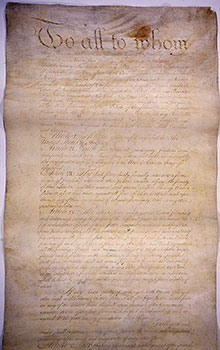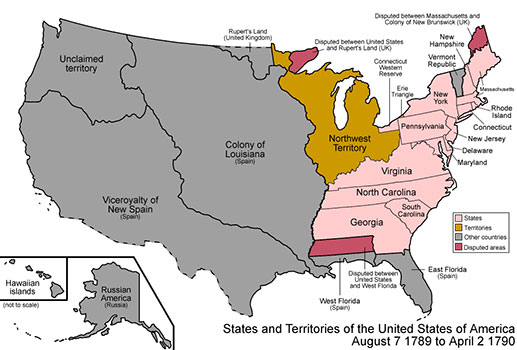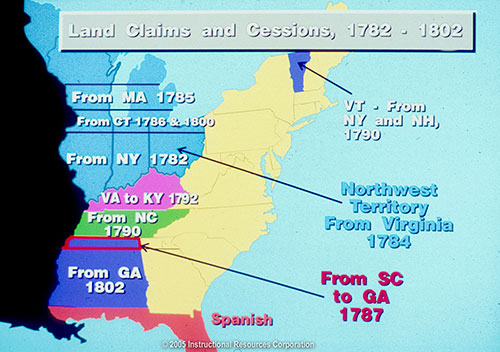Learn
A New Confederation
The Continental Congress
After America formally separated from England in 1776, the Continental Congress urged the colonies to begin writing new state constitutions. The Congress also formed a committee and appointed John Dickinson, a delegate from Delaware, as chairman. Although Dickinson had at one time opposed American independence, he was now tasked with helping to create its new government and prepare a national constitution.

The relationship between the states and the national government had not been defined yet, largely because the British colonies each had their own governors, councils, and colonial assemblies. This system encouraged colonial citizens to think of each colony as its own primary political unit and their allegiance was to the colony they lived in. The Revolutionary War had united the colonies in one common goal, but it had not united them as one nation. This issue challenged the Continental Congress to find a way to balance the interests of the new nation with those of the states.
After the Revolutionary War, many Americans believed that a republic – a system in which citizens rule through their elected representatives – was necessary so that power rested in the hands of elected leaders, rather than the uneducated masses. They also didn't want a monarchy like the tyrannical rule of Great Britain that they had just escaped.
The Continental Congress urged the colonies to write new state constitutions. In this process, there were obvious similarities of republican ideals, such as limiting the powers of governmental leaders. However, many state constitutions differed greatly, especially when it came to the right to vote. Although this new nation was more democratic than any other Western nation before, most states either directly forbade the right to vote to African Americans and women or made property ownership a requirement for voting eligibility.
The Continental Congress Debates
While the states were busy trying to write their individual constitutions, the Continental Congress was trying to draft a constitution that would bind together these thirteen "free and independent states" that wanted to maintain their sovereignty.
This task created tensions as the delegates struggled with three basic questions:
- Should states be represented by population or by size?
- Can power be divided between one supreme body and several smaller ones?
- Who gets western lands and how will they be governed?
The delegates to the Congress proposed a new set of laws called the Articles of Confederation. These new laws would create a confederation, or alliance, that shared power between the states and the national government. In this confederation, there was only one branch – a unicameral (or one house) congress. The executive (president) and judicial (federal court) branches that we have now did not exist under the Articles of Confederation.

Issues
- Since each state differed in terms of size, population, and wealth, representation for the states in Congress was a major issue. Because the delegates saw themselves as representatives of individual states, the Articles of Confederation gave each state one vote, regardless of size or population.
- The balance of power between the states and national government was also a major issue the delegates faced. Their solution in the Articles of Confederation was to give the states supreme power on some matters and the national government supreme power on others. For example, the national government had the power to declare war, make peace, and sign treaties and borrow money. However, the new national government created under the Articles contained no executive to enforce these powers and no national court system to interpret the meaning of the new laws.
- The third major issue the delegates faced was how to divide western lands (the lands west of the Appalachian Mountains) and how to govern them. Maryland had no claims to western lands as some other states did and feared that they would be overpowered by larger, more powerful states. Therefore, Maryland refused to approve the Articles until all western lands had been turned over to the national government. Once this happened, Maryland ratified the Articles of Confederation in March 1781.

"United States of America Under the Peace of 1783." Discovery Education, IRC, 2005, app.discoveryeducation.com/learn/player/128a00f2-b09f-4676-bf06-ad853389aa7a.
Getting Out of Debt
The United States had accrued a large war debt to France and private individuals from the Revolutionary War that it could not repay. It also couldn't pay the veterans who fought in the war.
During this time, states were continuing to print currency, which led to further inflation.
Lacking the power to tax its citizens, the new government was hard pressed to find a financial solution. The answer was found in land sales. After all western lands had been given to the national government, Congress divided up the territory for sale in 1785 and 1787 and set provisions for statehood that would further expand our territory.
Land Ordinances
The Land Ordinance of 1785 gave Congress the right to sell lands north of the Ohio River, east of the Mississippi River, and south of the Great Lakes in order to raise money to repay these war debts. The land could be surveyed and divided into 36 square mile townships with lots divided into one square mile, or 640 acre, plots to be sold for not less than $1 per acre. The 16th section of each township would be sold for the maintenance of public schools.

"The Beginnings of Ohio, 1784-1800." Discovery Education, IRC, 2005, app.discoveryeducation.com/learn/player/a76ed42a-14ee-499a-a64f-f65668ad2a3b.
Congress later passed the Northwest Ordinance of 1787 which created the first organized territory of the new United States - the Northwest Territory.
Slavery was permanently excluded from the Northwest Territory.

The Northwest Ordinance of 1787 also created provisions for admitting new states to the Union:
- Congress would appoint a territorial governor and judges.
- When a territory had 5,000 voting residents, settlers could write a temporary constitution and elect their own government.
- When the territory reached 60,000 free inhabitants, it could write a state constitution to be approved by Congress before it could be granted statehood.
Both land policies were important for establishing future growth of the nation.

"Western Land Claims by the Original 13 States." Discovery Education, IRC, 2005, app.discoveryeducation.com/learn/player/96842c7d-ad91-4213-b927-92fb4f9386ef.
Strengths and Weaknesses of the Articles of Confederation
The Articles of Confederation purposefully created to a weak national government. It was to unify the thirteen individual states and provide for a common defense, but still allow states to maintain their sovereignty.
| Strengths | Weaknesses |
|---|---|
| Created a central government | No power to collect taxes |
| Power to declare war | No judiciary or executive branch |
| Power to make peace and sign treaties | No power to control trade among states |
| Could govern western lands and negotiate sales of land | No power to raise troops |
| Power to borrow money | No power to regulate currency (money) |
Despite many problems, while under the Articles, the states fought and won independence from England, negotiated a peace treaty with European powers, and laid the framework for the present-day government.
Read The Articles of Confederation to learn more.